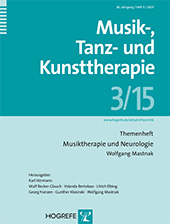Musiktherapie als Regulationstherapie
Abstract
Zusammenfassung. Das Kremser Modell der Musiktherapie (entwickelt an der IMC Fachhochschule Krems unter der Leitung von Gerhard Tucek) integriert wesentliche Elemente der Chronobiologie sowie der Regulationsmedizin und lässt sich konzeptionell am ehesten dem biopsychosozialen Modell zuordnen. Der Artikel beleuchtet ausgehend von den Systemtheorien das gängige biomedizinische Menschenbild und das von ihm abgeleitete Gesundheitsverständnis aus Sicht der biopsychosozialen Medizin und der Chronobiologie. Nach Ausführungen zur Regulationsmedizin wird schließlich die Musiktherapie im Kontext der Regulation dargestellt.
Abstract. The Krems model of music therapy, developed at the University of Applied Sciences in Krems under the guidance of Gerhard Tucek, integrates core elements of chronobiology and regulatory medicine, and shows certain similarities to biopsychosocial concepts. On the basis of systems theories, the article focuses on common biomedical views of man as well as their influence on health concepts in biopsychosocial medical and chronobiological contexts. Following an introduction to the principles of regulatory medicine, music therapy in the context of regulation is described.
Literatur
(2012). Ultradian und circadian Rhythms During Day and Night in Normal and COPD Subjects. Stud Health Technology Informatics, 180, 1120 – 1122.
(2004). Komplexe Systeme und Strukturprinzipien der Selbstregulation im fächerübergreifenden Unterricht: Eine Lernprozessstudie in der SII. Zeitschrift für Didaktik der Naturwissenschaften, 10, 163 – 181.
(2013). Urinary Interleukin-8 Is a Biomarker of Stress in Emergency Physicians, Especially with Advancing Age–The JOBSTRESS* Randomized Trial. PLoS ONE, 8 (8), e71658. doi:10.1371/journal.pone.0071658
(2001). Neurologisch-topische Diagnostik (7. Aufl.). Stuttgart: Thieme
(2009). Geschichte der Medizin (6. Aufl.). Heidelberg: Springer
(2005). Das biopsychosoziale Krankheitsmodell: Grundzüge eines wissenschaftlich begründeten ganzheitlichen Verständnisses von Krankheit. Psychologische Medizin, 16 (2), 3 – 12.
(1977). The need for a new medical model: a challenge for biomedicine. Science, 196, 129 – 136.
(1994). Das Quark und der Jaguar: Die Suche nach einer umfassenden Theorie. München: Piper.
(1998). Chronobiologie und Chronomedizin: Biologische Rhythmen, Medizinische Konsequenzen. Stuttgart: Hippokrates.
(2011). The Social Origins of Music. Dissertation. Humbolt-Universität zu Berlin.
(2013). Neurocognitive and Somatic Components of Temperature Increases during g-Tummo Meditation: Legend and Reality. PLoS ONE, 8 (3), e58244. doi: 10.1371/journal.pone.0058244
(1998). Einführung in die allgemeine Systemtheorie (2. Aufl.). München: Fink Verlag.
(Hrsg.). (2010). Neuropsychologie psychischer Störungen (2. Aufl.) Berlin: Springer.
(2004). Was sind komplexe Systeme? Komplexitätsforschung als integrative Wissenschaft. Beitrag 1. Wissenschaftliches Symposium der Deutsch-Japanischen Gesellschaft für integrative Wissenschaft am 14. Oktober 2004.
(Hrsg.). (2009). Das System der Grundregulation. Grundlagen einer ganzheitsbiologischen Medizin (11. Aufl.). Stuttgart: Haug.
(2012). Effects of Psychological Stress on Innate Immunity and Metabolism in Humans: A Systematic Analysis. PLoS ONE, 7(9), e43232. doi:10.1371/journal.pone.0043232.
(1970). Die Versammlung der Gesellschaft deutscher Naturforscher und Ärzte 1869 in Innsbruck. Berichte des naturwissenschaftlich-medizinischen Vereins in Innsbruck (Band 58, S. 13 – 34). Innsbruck: Naturwissenschaftlich-Medizinischer Verein in Innsbruck.
(2006). Mensch im Stress: Psyche, Körper, Moleküle. München: Spektrum Akademischer Verlag.
(2001). Wie das Gehirn die Seele macht. Vorlesung im Rahmen der 51. Lindauer Psychotherapiewochen.
(2005). Physiologie des Menschen: Mit Pathophysiologie (29. Aufl.). London: Springer.
(2005). Physiologie des Menschen–mit Pathophysiologie (29. Aufl.). Heidelberg: Springer.
(2003). Wie viele Zellen hat der Mensch? Spektrum.de. Zugriff am 02. 09. 2013. Verfügbar unter http://www.spektrumdirekt.de/artikel/620672& z=859070
(2012). Taschenatlas Physiologie (8. Aufl.). Stuttgart: Thieme.
(2006). Circadian and ultradian rhythms in heart rate variability. Biomedizinische Technik. Biomedical engineering, 51, 155 – 158.
(1996). Heart rate variability: standards of measurement, physiological interpretation and clinical use. Circulation, 93, 1043 – 1065.
(2013). Heart rate variability in normal and pathological sleep. Frontiers in Physiology, 4 (294). doi: 10.3389/fphys.2013.00294.
(2002). The inflamatory reflex. Nature, 420, 853 – 859.
(2012). Neuroanatomie: Struktur und Funktion (5. Aufl.). München: Urban & Fischer.
(2015). Musiktherapie: Musik und Gesang bei Komapatienten. In B. Bernatzky & G. Kreutz (Hrsg.), Musik und Medizin: Chancen für Therapie, Prävention und Bildung (S. 177 – 188). Wien: Springer.
(1948). Preamble to the Constitution of the World Health Organization as adopted by the International Health Conference, New York, 19 – 22 June 1946; signed on 22 July 1946 by the representatives of 61 States (Official Records of the WHO, No. 2, p. 100) and entered into force on 7 April 1948.


